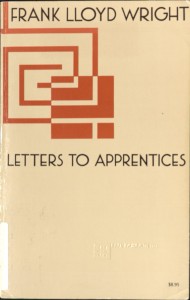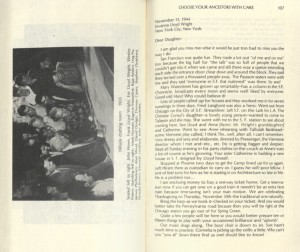 Letters to Apprentices: Frank Lloyd Wright is a publication containing selected letters from Frank Lloyd Wright to his many apprentices. Alongside the many letters is commentary from the editor of the book and the Director of Archives of The Frank Lloyd Wright Foundation and The Frank Lloyd Wright Memorial Foundation, Bruce Brooks Pfeiffer. This commentary provides context for some of the letters and information on the goings-on in Wright’s life and works at the time. The letters themselves contribute valuable insights into Wright’s personality and work, as well as those of the Taliesin Fellows to whom the correspondence primarily concerns.
Letters to Apprentices: Frank Lloyd Wright is a publication containing selected letters from Frank Lloyd Wright to his many apprentices. Alongside the many letters is commentary from the editor of the book and the Director of Archives of The Frank Lloyd Wright Foundation and The Frank Lloyd Wright Memorial Foundation, Bruce Brooks Pfeiffer. This commentary provides context for some of the letters and information on the goings-on in Wright’s life and works at the time. The letters themselves contribute valuable insights into Wright’s personality and work, as well as those of the Taliesin Fellows to whom the correspondence primarily concerns.
In the preface, Pfeiffer explains how the letters mostly pertain to “the Taliesin Fellowship, that group of young men and women who were his apprentices from 1932 to 1959…[and] throughout those years many hundreds of Taliesin Fellows arrived” (pg. ix). The book seeks to capture the experiences of Taliesin Fellows, both in their work and their relationships with Wright. As arguably the most influential and prolific architect of his time, the opportunity to work with Wright was undoubtedly one of the greatest opportunities any young architect could hope for. The style of the Taliesin Fellowship, preparing students to be architects within only a few years and nothing like a standard curriculum, influenced training programs and apprenticeships across the country, in addition to giving the program a reputation that increased work opportunities. Over time, “as there came an increase in architectural work, the demands required of him to answer letters…necessitated that letters to applicants and former apprentices be briefer,” so the longest and perhaps most interesting letters are near the start of the Taliesin Fellowship in 1932.
Interestingly, Wright made a point to note in a 1932 letter to an applicant that Taliesin “contemplates exactly 100 apprentices, about 40 girls and 60 boys,” and was intended to serve as an extension of the Taliesin studio  (pg. 14). The fact that Wright, as early as 1932, made a point of including women apprentices is fascinating, even somewhat radical. Today, many still note an excess of gender discrimination in the field of architecture, as well as a dearth of female architects. In contrast, Wright dedicated 40% of the apprenticeships to ensuring women had opportunities. While there may have been no follow-through on this goal (Wright notes that he has decreased the number of fellows to 70 and mentions that the fellowship would likely be only 30% girls), there are letters to female apprentices throughout the collection. It is worthwhile to note that Wright offers less praise for his female students than his male students, sometimes merely relegating them to “furnish” a project or “housebreak the owners” (pg. 96). He also proves somewhat haughty at times, such as after a student left Taliesin, telling him, “we all make errors of judgment, if we have any judgment, and being a young fellow, you ought to acquire a collection of errors in your own name as I have in mine,” indicating that he believes the student’s abandonment of Taliesin to be a mistake he will later regret (pg. 97). Wright also showed himself through the letters to be dedicated to keeping up with his pupils, often offering them work or advice, and asking about their families and personal lives. While Wright definitely showed a preference for his male students, he remained a loyal correspondent with many of his students whom he respected.
(pg. 14). The fact that Wright, as early as 1932, made a point of including women apprentices is fascinating, even somewhat radical. Today, many still note an excess of gender discrimination in the field of architecture, as well as a dearth of female architects. In contrast, Wright dedicated 40% of the apprenticeships to ensuring women had opportunities. While there may have been no follow-through on this goal (Wright notes that he has decreased the number of fellows to 70 and mentions that the fellowship would likely be only 30% girls), there are letters to female apprentices throughout the collection. It is worthwhile to note that Wright offers less praise for his female students than his male students, sometimes merely relegating them to “furnish” a project or “housebreak the owners” (pg. 96). He also proves somewhat haughty at times, such as after a student left Taliesin, telling him, “we all make errors of judgment, if we have any judgment, and being a young fellow, you ought to acquire a collection of errors in your own name as I have in mine,” indicating that he believes the student’s abandonment of Taliesin to be a mistake he will later regret (pg. 97). Wright also showed himself through the letters to be dedicated to keeping up with his pupils, often offering them work or advice, and asking about their families and personal lives. While Wright definitely showed a preference for his male students, he remained a loyal correspondent with many of his students whom he respected.
As one of the most famous architects in history, Frank Lloyd Wright remains a fascinating figure to study, for the controversy of his personal life, for his celebrity, and for his unique style. There is something enigmatic about Wright. He is remembered as fiercely proud of his own accomplishments, selective in his taste, and loathe to give compliments. Yet in his correspondence with his students, he is shown to be loyal, to have great faith in his students’ talents so long as they display a similar loyalty and dedication to their work, supportive of female architects (certainly for the time period), and yes, a bit haughty, yet more affable than he is remembered. Letters are a unique historical resource – they unveil personality and information that, for example, Wright’s autobiography, would not. These letters were never meant to be ready by anyone other than the recipients, making them a more unvarnished, honest source than something written to be read publicly. In this sense, Wright’s letters are a powerful resource. As much of a celebrity as he was, and as much as he and his work has been researched, no source could explore his personality and the complicated relationships he had with his apprentices as well as the letters in Letters to Apprentices do. The collection of letters provides captivating insights into one of America’s best-known architects, supplying glimpses into Frank Lloyd Wright and the proteges who followed him in shaping modern architecture.
